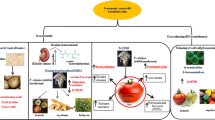
Overview
- Describes genetic transformation methods such as direct DNA transfer
- Presents the latest tools and techniques in the transformation of different food crops
- Gives a detailed account of the commercial transgenic crops as well as those in pipeline
Access this book
Tax calculation will be finalised at checkout
Other ways to access
About this book
This book presents up-to-date information on various vector-less/direct (physical, chemical) and vector-mediated/indirect (Agrobacterium-mediated) plant transformation techniques. It summarizes various strategies that facilitate a gene from lower organism to be expressed in higher plants and also in silico designing of synthetic gene for higher expression. It also highlights the importance of strong promoters to drive the expression of transgene(s). This book encompasses the advantages and drawbacks of cisgenesis and transgenesis, their implications towards sustainable crop improvement, and their future prospects. The importance, limitations, challenges, recent developments, and future prospects of molecular pharming is also discussed. The book concludes with a chapter that summarizes the major contribution of GM-crops towards global food security and economy, advances in genome editing for crop improvement, challenges and risk associated with therelease of GM-crops, and the future of GM technology.
This book is meant for students and researchers in the field of life sciences, food science, and agriculture.
Similar content being viewed by others
Keywords
Table of contents (6 chapters)
Authors and Affiliations
About the author
Dr. Bhupendra Koul is an assistant professor in the Department of Biotechnology, School of Bioengineering and Biosciences, Lovely Professional University (LPU), Punjab, India. During his PhD at the Plant Transgenics Lab, CSIR-National Botanical Research Institute (CSIR-NBRI), Lucknow, he worked on the optimization, introduction, and expression of modified full-length and truncated versions of Bt-cry1Ab and 1Ac genes in tomato for developing non-chimeric and stable transgenic lines resistant to two lepidopteran insects (Helicoverpa armigera and Spodoptera litura) and evaluated the performance of both the versions of cry1Ab and 1Ac genes for the stability and efficacy of insecticidal toxin in transgenic plants. He also evaluated the performance and role of various cis-motifs of synthetic promoters for overexpression of genes in tomato and performed comparative in silico analyses of several cry1A genes for toxicity to target insects. He has also optimized the regeneration and Agrobacterium-mediated transformation of Stevia (Stevia rebaudiana Bertoni) and has developed herbicide-resistant transgenic Stevia for effective weed management in Stevia cultivation. He has 5 years of research experience and was awarded CSIR-Senior Research Fellowship (SRF) in the year 2013. He also has 8 years of teaching experience and has received the Teacher Appreciation Award 2016 from LPU in the discipline of biotechnology, through the MHRD Minister, Government of India. He has designed the full-length synthetic cry1Ac gene (GenBank: KP195020.1) and has published 45 research papers in national and international journals as well as 21 book chapters and 2 authored book with Springer Nature.
Bibliographic Information
Book Title: Cisgenics and Transgenics
Book Subtitle: Strategies for Sustainable Crop Development and Food Security
Authors: Bhupendra Koul
DOI: https://doi.org/10.1007/978-981-19-2119-3
Publisher: Springer Singapore
eBook Packages: Biomedical and Life Sciences, Biomedical and Life Sciences (R0)
Copyright Information: The Editor(s) (if applicable) and The Author(s), under exclusive license to Springer Nature Singapore Pte Ltd. 2022
Hardcover ISBN: 978-981-19-2118-6Published: 01 September 2022
Softcover ISBN: 978-981-19-2121-6Published: 02 September 2023
eBook ISBN: 978-981-19-2119-3Published: 31 August 2022
Edition Number: 1
Number of Pages: XXIII, 424
Number of Illustrations: 36 b/w illustrations, 56 illustrations in colour
Topics: Agriculture, Biomedical Engineering/Biotechnology, Plant Breeding/Biotechnology, Food Science, Plant Genetics and Genomics



